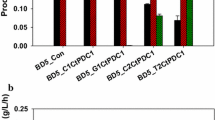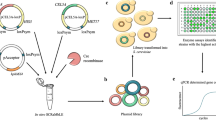Abstract
In this study, the production of enantiomerically pure (1R,4S,6S)-6-hydroxy-bicyclo[2.2.2]octane-2-one ((−)-2) through stereoselective bioreduction was used as a model reaction for the comparison of engineered Saccharomyces cerevisiae and engineered Escherichia coli as biocatalysts. For both microorganisms, over-expression of the gene encoding the NADPH-dependent aldo-keto reductase YPR1 resulted in high purity of the keto alcohol (−)-2 (>99% ee, 97–98% de). E. coli had three times higher initial reduction rate but S. cerevisiae continued the reduction reaction for a longer time period, thus reaching a higher conversion of the substrate (95%). S. cerevisiae was also more robust than E. coli, as demonstrated by higher viability during bioreduction. It was also investigated whether the NADPH regeneration rate was sufficient to supply the over-expressed reductase with NADPH. Five strains of each microorganism with varied carbon flux through the NADPH regenerating pentose phosphate pathway were genetically constructed and compared. S. cerevisiae required an increased NADPH regeneration rate to supply YPR1 with co-enzyme while the native NADPH regeneration rate was sufficient for E. coli.







Similar content being viewed by others
References
Baba T, Ara T, Hasegawa M, Takai Y, Okumura Y, Baba M, Datsenko KA, Tomita M, Wanner BL, Mori H (2006) Construction of Escherichia coli K-12 in-frame, single-gene knockout mutants: the Keio collection. Mol Syst Biol 2:200.0008
Bergmeyer HU (1974) Methods of enzymatic analysis. Verlag Chemie, Academic, London
Boles E, Zimmermann FK (1994) Open reading frames in the antisense strands of genes coding for glycolytic enzymes in Saccharomyces cerevisiae. Mol Gen Genet 243(4):363–368
Bruinenberg PM (1986) The NADP(H) redox couple in yeast metabolism. Antonie Van Leeuwenhoek 52(5):411–429
Burton SG (2001) Development of bioreactors for application of biocatalysts in biotransformations and bioremediation. Pure Appl Chem 73(1):77–83
Chartrain M, Greasham R, Moore J, Reider P, Robinson D, Buckland B (2001) Asymmetric bioreductions: application to the synthesis of pharmaceuticals. J Mol Catal B Enzym 11(4–6):503–512
Chin-Joe I, Haberland J, Straathof AJJ, Jongejan JA, Liese A, Heijnen JJ (2002) Reduction of ethyl 3-oxobutanoate using non-growing baker's yeast in a continuously operated reactor with cell retention. Enzyme Microb Technol 31(5):665–672
Csonka LN, Fraenkel DG (1977) Pathways of NADPH formation in Escherichia coli. J Biol Chem 252(10):3382–3391
D'Arrigo P, Pedrocchi-Fantoni G, Servi S (1997) Old and new synthetic capacities of baker's yeast. Adv Appl Microbiol 44:81–23
Ema T, Yagasaki H, Okita N, Takeda M, Sakai T (2006) Asymmetric reduction of ketones using recombinant E. coli cells that produce a versatile carbonyl reductase with high enantioselectivity and broad substrate specificity. Tetrahedron 62:6143–6149
Gietz RD, Schiestl RH, Willems AR, Woods RA (1995) Studies on the transformation of intact yeast cells by the LiAc/SS-DNA/PEG procedure. Yeast 11(4):355–360
Grabowska D, Chelstowska A (2003) The ALD6 gene product is indispensable for providing NADPH in yeast cells lacking glucose-6-phosphate dehydrogenase activity. J Biol Chem 278(16):13984–13988
Guldener U, Heck S, Fielder T, Beinhauer J, Hegemann JH (1996) A new efficient gene disruption cassette for repeated use in budding yeast. Nucleic Acids Res 24(13):2519–2524
Hilterhaus L, Liese A (2007) Building blocks. Adv Biochem Eng Biotechnol 105:133–173
Hua Q, Yang C, Baba T, Mori H, Shimizu K (2003) Responses of the central metabolism in Escherichia coli to phosphoglucose isomerase and glucose-6-phosphate dehydrogenase knockouts. J Bacteriol 185(24):7053–7067
Ishige T, Honda K, Shimizu S (2005) Whole organism biocatalysis. Curr Opin Chem Biol 9(2):174–180
Johanson T, Katz M, Gorwa-Grauslund MF (2005) Strain engineering for stereoselective bioreduction of dicarbonyl compounds by yeast reductases. FEMS Yeast Res 5(6–7):513–525
Johanson T, Carlquist M, Olsson C, Rudolf A, Frejd T, Gorwa-Grauslund MF (2008) Reaction and strain engineering for improved stereo-selective whole-cell reduction of a bicyclic diketone. Appl Microbiol Biotechnol 77(5):1111–1118
Kaluzna IA, Matsuda T, Sewell AK, Stewart JD (2004) Systematic investigation of Saccharomyces cerevisiae enzymes catalyzing carbonyl reductions. J Am Chem Soc 126(40):12827–12832
Karhumaa K, Hahn-Hagerdal B, Gorwa-Grauslund MF (2005) Investigation of limiting metabolic steps in the utilization of xylose by recombinant Saccharomyces cerevisiae using metabolic engineering. Yeast 22(5):359–368
Kataoka M, Sri Rohani LP, Wada M, Kita K, Yanase H, Urabe I, Shimizu S (1998) Escherichia coli transformant expressing the glucose dehydrogenase gene from Bacillus megaterium as a cofactor regenerator in a chiral alcohol production system. Biosci Biotechnol Biochem 62(1):167–169
Katz M, Sarvary I, Frejd T, Hahn-Hagerdal B, Gorwa-Grauslund MF (2002) An improved stereoselective reduction of a bicyclic diketone by Saccharomyces cerevisiae combining process optimization and strain engineering. Appl Microbiol Biotechnol 59(6):641–648
Katz M, Frejd T, Hahn-Hägerdal B, Gorwa-Grauslund MF (2003) Efficient anaerobic whole cell stereoselective bioreduction with recombinant Saccharomyces cerevisiae. Biotechnol Bioeng 84(5):573–582
Kromer JO, Wittmann C, Schroder H, Heinzle E (2006) Metabolic pathway analysis for rational design of L-methionine production by Escherichia coli and Corynebacterium glutamicum. Metab Eng 8(4):353–369
Kwon DH, Kim MD, Lee TH, Oh YJ, Ryu YW, Seo JH (2006) Elevation of glucose 6-phosphate dehydrogenase activity increases xylitol production in recombinant Saccharomyces cerevisiae. J Mol Catal B Enzym 43(1–4):86–89
Liese A, Seelbach K, Wandrey C. 2006. Industrial Biotransformations: Wiley-VCH
Milagre HMS, Milagre CDF, Moran PJS, Santana MHA, Rodrigues JAR (2005) Reduction of ethyl benzoylformate mediated by Saccharomyces cerevisiae entrapped in alginate fibers with double gel layers in a continuously operated reactor. Enzyme Microb Technol 37(1):121–125
Minard KI, McAlister-Henn L (2001) Antioxidant function of cytosolic sources of NADPH in yeast. Free Radic Biol Med 31(6):832–843
Mumberg D, Muller R, Funk M (1995) Yeast vectors for the controlled expression of heterologous proteins in different genetic backgrounds. Gene 156(1):119–122
Murai T, Tokushige M, Nagai J, Katsuki H (1971) Physiological functions of NAD- and NADP-linked malic enzymes in Escherichia coli. Biochem Biophys Res Commun 43(4):875–881
Nikolova P, Ward OP (1992) Whole cell yeast biotransformations in 2-phase systems—effect of solvent on product formation and cell structure. J Ind Microbiol 10(3–4):169–177
Patel RN (2006) Biocatalysis: synthesis of chiral intermediates for drugs. Curr Opin Drug Discov Devel 9(6):741–764
Rodriguez S, Schroeder KT, Kayser MM, Stewart JD (2000) Asymmetric synthesis of beta-hydroxy esters and alpha-alkyl-beta-hydroxy esters by recombinant Escherichia coli expressing enzymes from baker's yeast. J Org Chem 65(8):2586–2587
Salter GJ, Kell DB (1995) Solvent selection for whole cell biotransformations in organic media. Crit Rev Biotechnol 15(2):139–177
Sambrook J, Fritch E, Maniatis T (1989) Molecular cloning: a laboratory manual. Cold Spring harbor Laboratory, Cold Spring Harbor
Sauer U, Canonaco F, Heri S, Perrenoud A, Fischer E (2004) The soluble and membrane-bound transhydrogenases UdhA and PntAB have divergent functions in NADPH metabolism of Escherichia coli. J Biol Chem 279(8):6613–6619
Schmid A, Dordick JS, Kiener A, Wubbolts M, Witholt B (2001) Industrial biocatalysis today and tomorrow. Nature 409:258–268
Stewart JD (2000) Organic transformations catalyzed by engineered yeast cells and related systems. Curr Opin Biotechnol 11(4):363–368
Stryer L (2000) Biochemistry. W. H. Freeman, New York
Terpe K (2006) Overview of bacterial expression systems for heterologous protein production: from molecular and biochemical fundamentals to commercial systems. Appl Microbiol Biotechnol 72(2):211–222
Walton AZ, Stewart JD (2004) Understanding and improving NADPH-dependent reactions by nongrowing Escherichia coli cells. Biotechnol Prog 20(2):403–411
Widegren M, Dietza M, Friberg A, Frejd T, Hahn-Hägerdal B, Gorwa-Grauslund M, Katz M (2006) The synthesis of bicyclo[2.2.2]octan-2, 6-dione revisited. Synthesis 20:3527–3530
Woodley JM (2008) New opportunities for biocatalysis: making pharmaceutical processes greener. Trends Biotechnol 26(6):321–327
Acknowledgements
This work was financed by the Research School in Pharmaceutical Sciences (FLÄK) and the Royal Physiographic Society in Lund and the Swedish research council (VR). We thank Professor Bärbel Hahn-Hägerdal for valuable discussions and Mathieu Heulot for his help with the E. coli-catalysed reductions.
Author information
Authors and Affiliations
Corresponding author
Additional information
Nádia Skorupa Parachin and Magnus Carlquist have contributed equally to the paper.
Rights and permissions
About this article
Cite this article
Skorupa Parachin, N., Carlquist, M. & Gorwa-Grauslund, M.F. Comparison of engineered Saccharomyces cerevisiae and engineered Escherichia coli for the production of an optically pure keto alcohol. Appl Microbiol Biotechnol 84, 487–497 (2009). https://doi.org/10.1007/s00253-009-1964-1
Received:
Revised:
Accepted:
Published:
Issue Date:
DOI: https://doi.org/10.1007/s00253-009-1964-1




